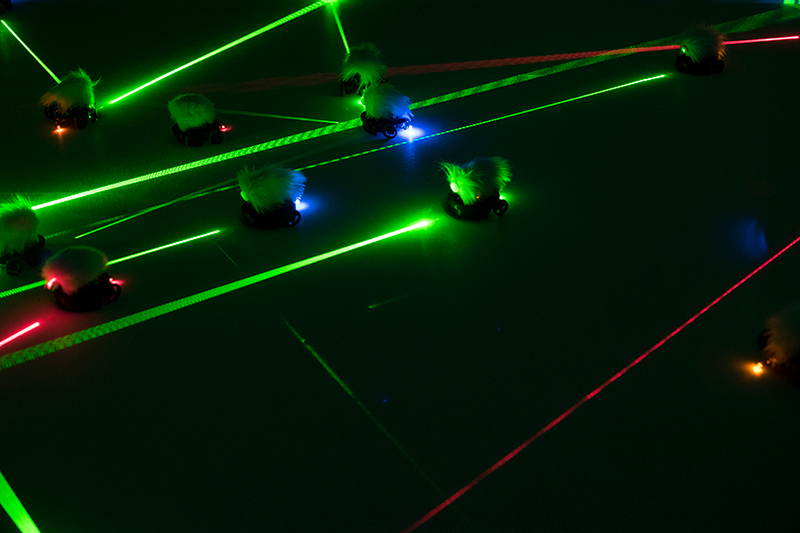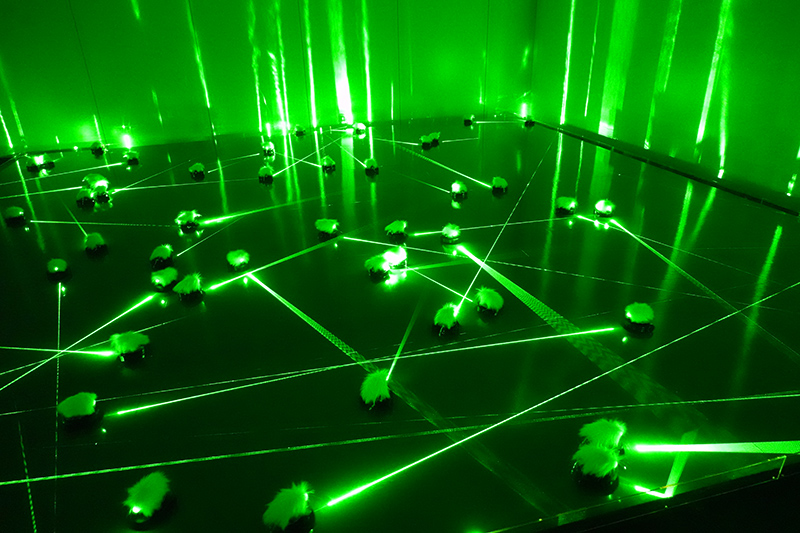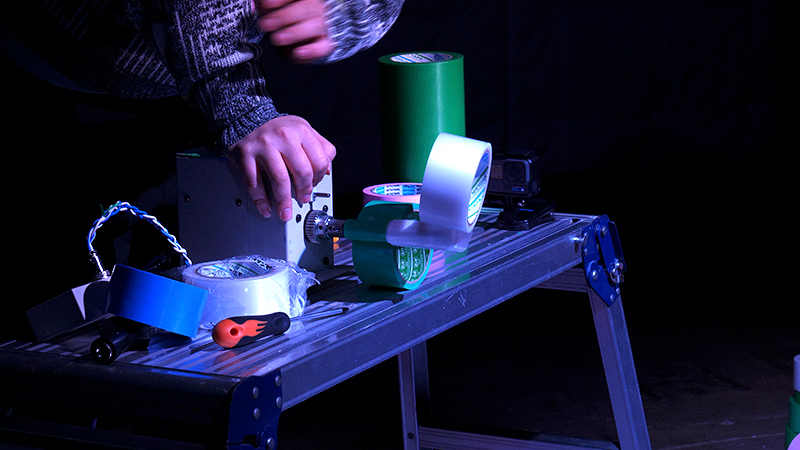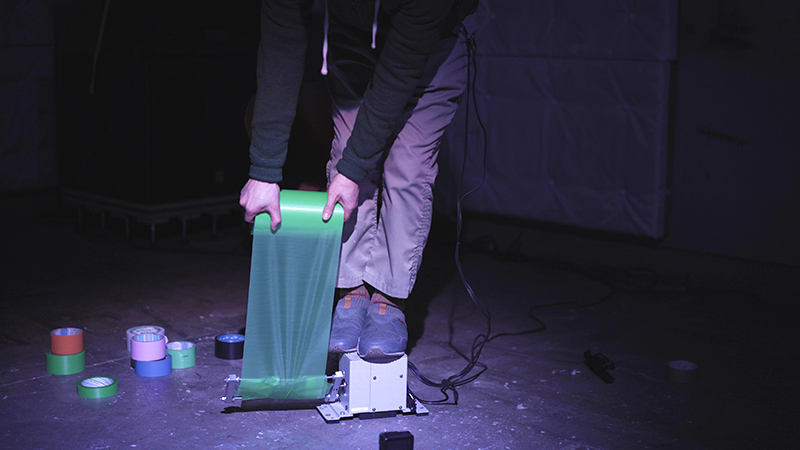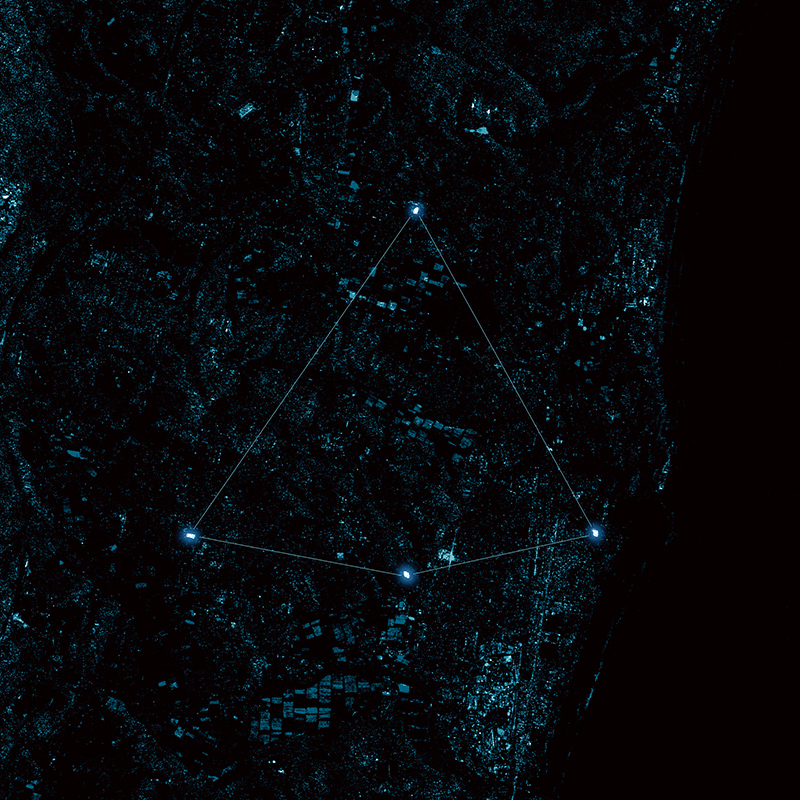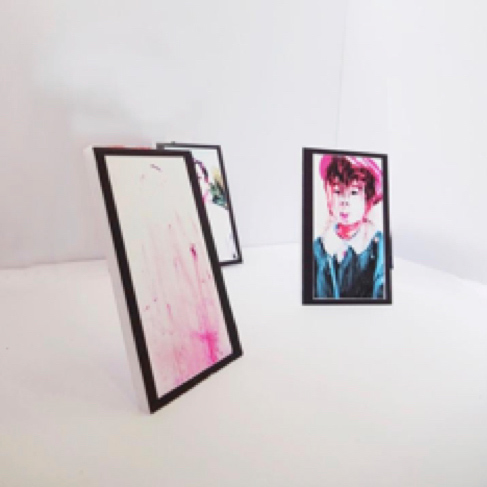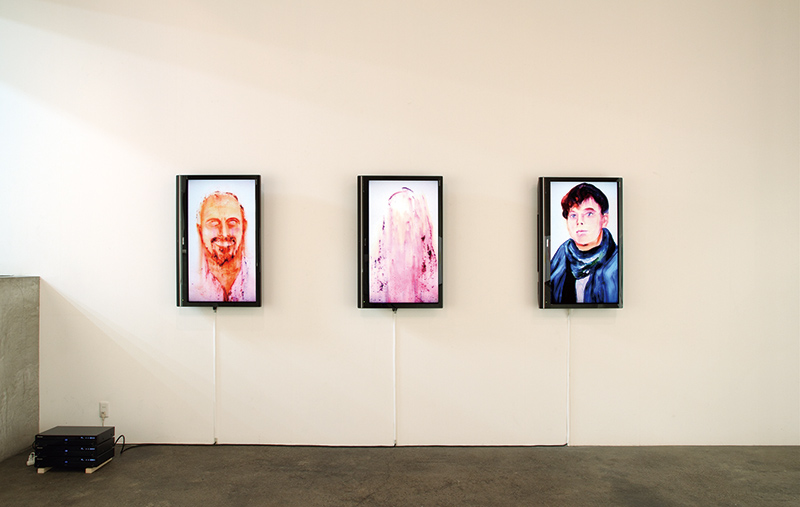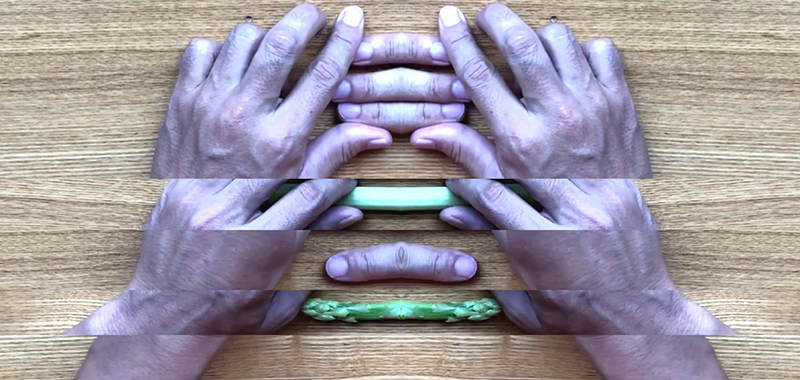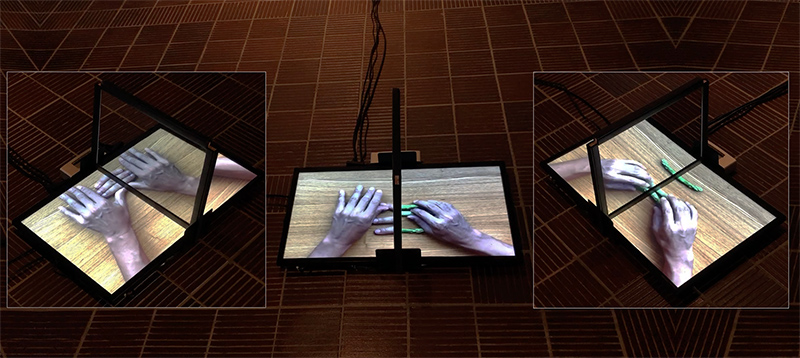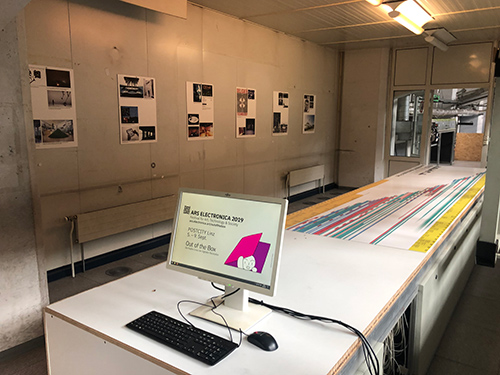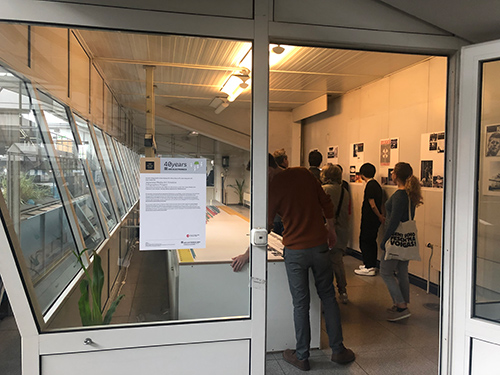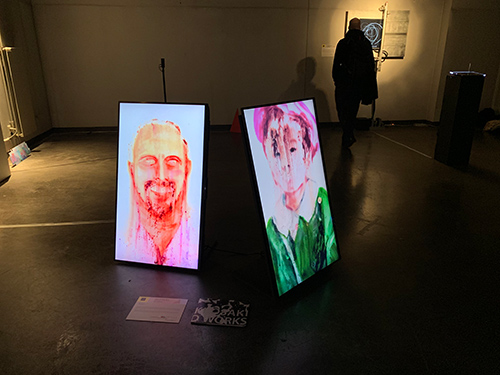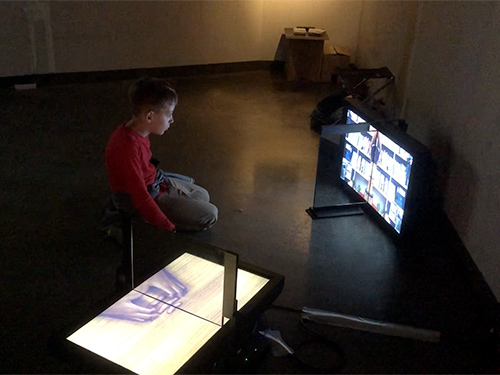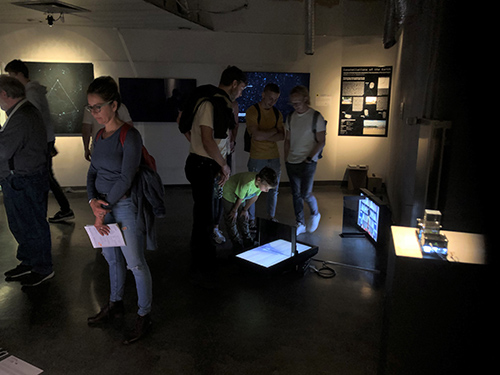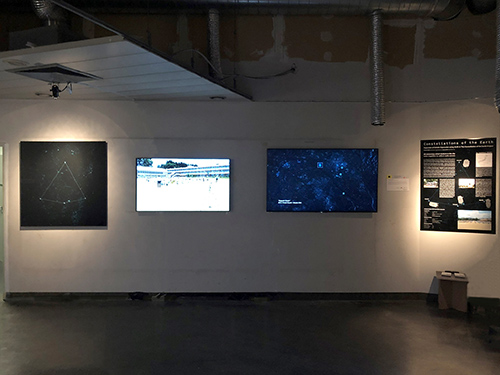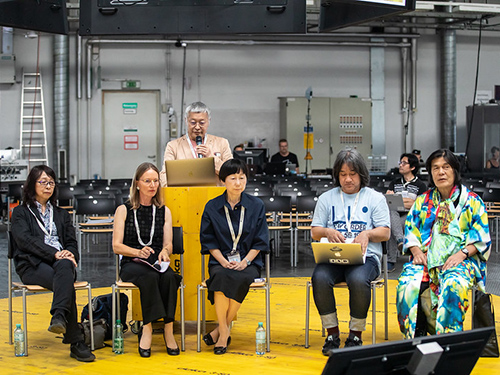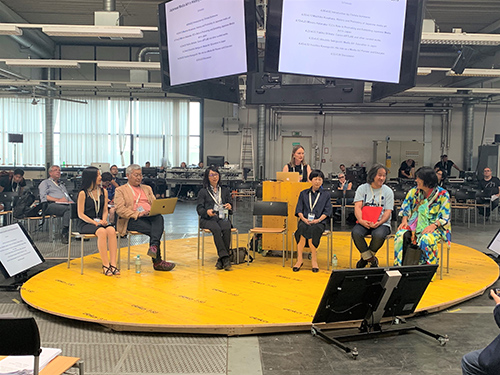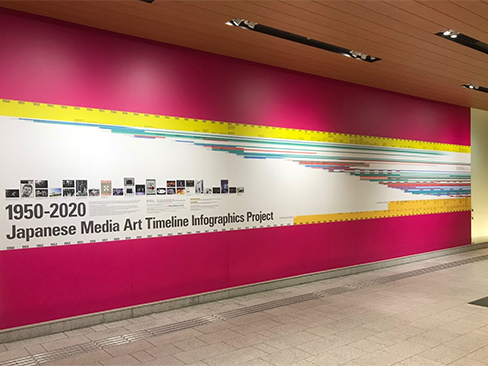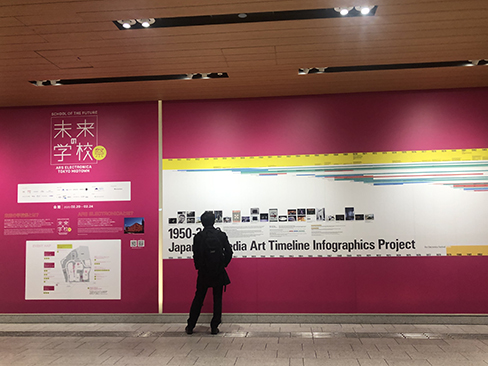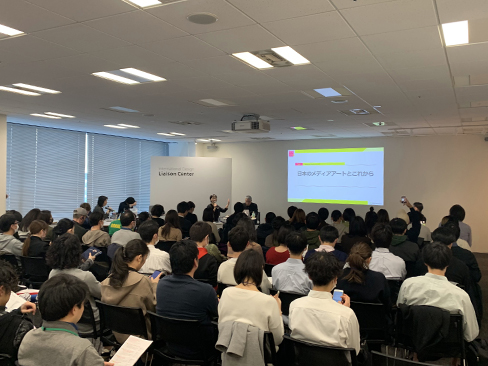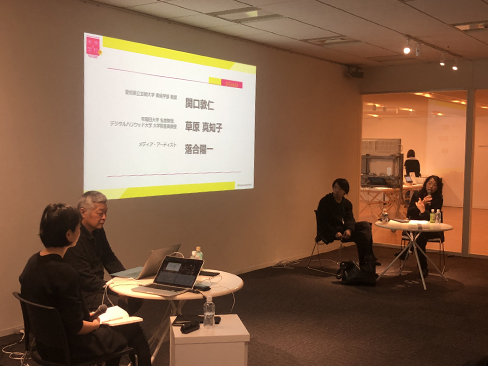- Exhibition&Screening&Talk event&Performance
Ars Electronica Festival 2019 "Out of the Box – The Midlife Crisis of the Digital Revolution"
As part of our overseas promotion program, the Japan Media Arts Festival organized by the Agency for Cultural Affairs, Government of Japan will participate in Ars Electronica Festival 2019, which will be held from September 5th to 9th 2019 in Linz, Austria.
Theme Exhibitions:"Out of the Box - The Midlife Crisis of the Digital Revolution"
Ars Electronica has followed, anticipated and analyzed the digital revolution and its origins, its successes, even its follies. As a festival for art, technology and society, the cultural and social significance of new technical and scientific developments has always been at its forefront. This year, Ars Electronica celebrates its 40th anniversary and as always turns its gaze forward, in an artistic and scientific survey of digital reality, its future prospects and our options for action.
In keeping with its title "Out of the Box – The Midlife Crisis of the Digital Revolution," we embark on an expedition to artistically and scientifically survey our modern world and its techno-economic influences, its future prospects and our options for action.
"Out of the Box means for us all: get out of our comfort zones! In order for humanity to maintain its capacity to act in the face of burning issues such as artificial intelligence, the melding of genetics and bioengineering and the ecological destruction of our planet, we must venture into the unknown territory of the digital systems we humans created, using art to look past our own garden walls in order to determine what is possible and exceed it."
40 Years of Ars Electronica – 40 Years of Art Thinking
Art as a critical thinker’s "second opinion" on the digital revolution.
Being a festival for art, technology and society means using the methods of art and the sensorium of artists to observe and analyze possible future transformations as well as those currently happening, and to come to conclusions about their cultural and social dimensions and their consequences.
The time-honored principle of artistic thought and action "making the invisible visible," the curiosity to look at what’s behind the scenes and the impulse to make something better, dissatisfaction with simple answers, skepticism toward default solutions, an unflagging creativity in the search for new ways and means – all these are factors, originating in the artistic ecosystem, that are perfectly suited to help formulate the enlightened, critical and qualified perspectives that we urgently need on our path into the future. A path that must take into account the problems of the present no less than it needs visions of a better future.
The history of Ars Electronica and its multitude of visionary artistic projects, whose future scenarios, both positive and negative, are increasingly coming true, serve to prove the effectiveness of collaboration among art, technology and society. All the more remarkable is the visionary power of those who founded Ars Electronica 40 years ago.
Japan Media Arts Festival Overseas Promotion
Project Theme:"The Algorithms of Everyday Life and Bodily Expressions"
Term:2019. 9.5 (Thu) – 9.9 (Mon)
Venue:POSTCITY etc. (Linz, Austria)
General Director:SEKIGUCHI Atsuhito(Professor of Aichi University of the Arts)
This year marks the 40th anniversary of the Ars Electronica Festival. The event has established itself as an international platform for innovative media and has a global influence. With the Japan Media Arts Festival approaching its 22nd year, we are organizing an exhibition and symposium at the Ars Electronica Festival to illustrate the interconnected histories of these two events and their continuing relationship.
The 1960s saw a growth in poetic expression through the Fluxus movement. In Japan, the Cross Talk/Intermedia was held at the Yoyogi National Gymnasium in 1969 and the Osaka Expo in 1970, both of which featured video installations. These events marked the beginnings of Japanese media art. This has continued to evolve and expand since then while incorporating new mediums like video and computers as they appeared with each generation.
When society accepts new forms of media, it leads to new connections with daily life. Those connections are reiterated by artists and their own unique methods of expression. This concept forms the basis of the exhibition "The Algorithms of Everyday Life and Bodily Expressions."
General Director:SEKIGUCHI Atsuhito
Installation
"Lasermice"(2018)
Basement, POSTCITY
- Artist:KANNO So
- Genre:Media installation
- 22nd Art Division Excellence Award
- Outline:
- Organically producing rhythms with 60 small, self-propelled robots, an installation inspired by the synchronization seen in swarming organisms like fireflies. In swarming, individuals’ communication effects group movement in unison. While unseeable with lifeforms, this work uses laser communication to make the networks visible here. In response to each other’s laserbeams, the robots synchronously produce striking sounds to give the viewer a spatial sense of the ever-changing rhythms with their sounds and lights. As we sense beauty in the workings of nature, such as frog choruses, bell cricket songs and avian murmurations, might one not be able to produce something comparably worthy of appreciation by artificial means as well? Inspired by the algorithms of natural phenomena, this work constitutes an experiment seeking new forms of expression by creating algorithms that are not merely imitational, but original.
- Artist's Profile:
-
Born in Japan in 1984. Based in Berlin since 2013.
He considers the essential change of things brought about by the evolution of technology, and creates works to bring a new perspective upon them. Recent years he is focusing on multiple robotic systems.
This installation evokes images of collective landscapes of various scales within a cityscape—cars moving at rush hour or people walking on a busy crosswalk. While each unit may look like it is moving freely at first glance, the relationships between neighboring units actually determine the movement of the collective and create a kind of chaotic harmony. When a person moves away to a quiet back alley to escape the crowds and noise, this action itself is generated from the algorithm of interconnected relationships, like a stream emerging from a river. It is as if the intention of the group as a whole is expressed through the actions of its individual parts.
General Director:SEKIGUCHI Atsuhito
Performance
"Play Back" Curing tapes(2018)
Sept. 7th (Sat) 15:30-16:00 St. Florian Monastery(AI x Music St.Florian)
- Artist:SHOJIKI(KOBAYASHI Muku, TOKISATO Mitsuru)
- Genre:Sound Art
- Outline:
- In this perfomance, SHOJIKI use a motor to unravel rolls of curing tape. The motor’s movements, direction, and whether it is switched on or off, are all determined by switches manipulated by the performers. The unraveling tape generates a continuous peeling noise. Magnetic tapes, such as cassettes, play sounds when they are wound from one axis to another. SHOJIKI’s performance creates a metaphorical connection between unwinding a cassette tape and unraveling a roll of curing tape. Magnetic tapes are a sound reproduction medium coated with magnetic particles. On the other hand, curing tapes are coated with adhesive agents. Sounds can be recorded, played back, and erased from magnetic tapes over and over again. Similarly, curing tapes are made for temporary adhesion, so they can be taped on and peeled off multiple times. Magnetic tapes and curing tapes are both subject to wear and tear. Inspired by these coincidental connections between the two types of tapes, SHOJIKI illustrate the physical characteristics of sound reproduction mediums by "playing" curing tapes.
Artist's Profile
SHOJIKI
"SHOJIKI" is the duo of KOBAYASHI Muku [http://pocopuu.net/] and TOKISATO Mitsuru [http://tokisato.info/].
It was formed in 2016, based on the concept of playing as honestly as possible.
Recently we had performances using a motor and a curing tape, and in 2018 released a cassette tape "KB".
KOBAYASHI Muku
Born in 1992. In 2017, KOBAYASHI completed a Master’s Course at Tama Art University Graduate School of Art and Design’s Department of Information Design. In 2019, he completed a Master’s Course in sculpture at Kyoto University of Art & Design. He creates installations by combining videos and acoustic devices that make use of physical motions. "Pass for low" selected as Jury Selections at 22nd Art Division.
TOKISATO Mitsuru
Born in 1990. He graduated from International Academy of Media Arts and Sciences in 2010 and Tama Art University in 2012. TOKISATO’s works are based on digitalizing his experiments and observations of cameras and screens through measurements and cognition.
Sound is a physical phenomenon. The sound generated from a string is determined by its length. When tapes generally used for construction work are used as instruments, they can become arranged like a musical piece on the axis of time. This is evocative of John Cage’s Primitive performances and gives rise to exquisite intermedia combinations.
General Director:SEKIGUCHI Atsuhito
Symposium
Ars Electronica History Summit:"40 years of Japanese Media Art"
Sept. 5th (Thu) 16:00 - 17:00 POSTCITY, Conference Hall
Panelist: SHIKATA Yukiko, SEKIGUCHI Atsuhito, HATANAKA Minoru, KUSAHARA Machiko, KAWAGUCHI Yoichiro
Moderator: Christa SOMMERER
Japan Media Arts Festival has continued to support the overseas promotion of Japanese media arts at events like Ars Electronica ever since 1997.
For this reason, the Japan Media Arts Festival is now internationally recognized as a competition for appraising work in the media art field. Winners of the Japan Media Arts Festival have also gone on to participate and win at the Prix Ars Electronica. These artists and their works have had an enormous influence in the history of Japanese media art.
We will examine this interwoven relationship through the perspective of Japanese media art to commemorate the 40th anniversary of Ars Electronica.
-

SHIKATA Yukiko
Curator based in Tokyo. Director of "Open Water", visiting professor at Tama Art University and Tokyo Zokei University, lecturer at IAMAS and Meiji University. Worked as curator of Canon ARTLAB (1990-2001), Mori Art Museum (2002-2004), NTT ICC (2004-2010). Since later 1990s, she has been working independently and realized many experimental exhibitions and projects. Recent projects include SIAF 2014, KENPOKU ART 2016 (both as curator) and director of media art festival AMIT (2014-2018).
-

SEKIGUCHI Atsuhito
Professor of Aichi University of the Arts
Born in Tokyo 1958. Graduated Master Course of Paintings in Tokyo University of the Arts 1983. Professor of IAMAS(Institute of Advanced Media Arts and Sciences) 1998-2009. exhibited Canon Art LAB 9th [Connected Re-body] at Tokyo 1999. exhibited [Keikan] at Sendai Mediatheque 2002. President of IAMAS 2009-2013. exhibited [La Guerre] at Art LAB Aichi at Nagoya 2016. Directing of Art Robotics as project of Arts & Sciences for Art Analysis Research. -

HATANAKA Minoru
Born in 1968, HATANAKA graduated from Tama Art University. He joined NTT InterCommunication Center [ICC] in 1996, prior to the facility’s opening. He has curated exhibitions at ICC, including group shows such as Sound Art - Sound as Media (2000), silent dialogue (2007), [Internet Art Future]—Reality in Post Internet Era, SAKAMOTO Ryuichi with TAKATANI Shiro | Installation Music 2 IS YOUR TIME, and solo shows featuring the work of Dumb Type, Laurie ANDERSON, HACHIYA Kazuhiko, Rhizomatiks, ISOZAKI Arata, John WOOD and Paul HARRISON.
-

KUSAHARA Machiko
KUSAHARA Machiko is a professor emerita at Waseda University and holds Ph.D. in engineering from University of Tokyo. KUSAHARA started curating and writing in computer graphics and media art in early 80s. Since then she was involved in exhibitions such as 1985 Tsukuba Science Expo and the 1989 World Design Expo while serving in launching NTT/ICC and Tokyo Photographic Art Museum. She juried for international competitions including SIGGRAPH, Ars Electronica, ISEA, Japan Media Arts Festival and Hiroshima International Animation Festival among many others. She lectures worldwide and publishes widely on media art such as Device Art, as well as in the field of media archeology.
-

KAWAGUCHI Yoichiro
Emeritus Professor of the University of Tokyo, artist. Born in Tanegashima in Kyushu. KAWAGUCHI began research on a programming-based CG modelling method called the "Growth Model" in the dawn of the computer graphics age in 1976. He is a pioneer in Japanese media art and has attracted worldwide attention with his original works created with self-organizing technological methods derived from mathematical algorithms. In the early 1980s he officially presented the "Growth Model" at the international society SIGGRAPH. Every year he presents a 3D computer graphics images made using the MetaBall (implicit modeling) technique at the SIGGRAPH annual conference. At Ars Electronica, he unveiled a new work called "Ocean" in June 1986. In the following year, at the La Scala Theatre in Milan, he took part in the production of a collaborative project "GENESI" by bringing together CG images, orchestra, and folk dance. He has won numerous international grand prix awards in CG since the 1980s, including the Grand Prix in the Arts at Eurographics ’84 in 1984. In 2013, nominated for Medal with Purple Ribbon Award. He had great success with his solo exhibition at the MOCA Taipei in 2017 and the CDA (France) in 2018, awarded Prix D’Honneur in the Prix Bains Numériques, and inducted into the SIGGRAPH Academy.
-

Christa SOMMERER
Christa SOMMERER is an internationally renowned media artist, researcher and pioneer of interactive art. She is a professor and head of the Interface Cultures master program at University of Art and Design in Linz Austria. She previously held positions as Associate Professors at the IAMAS, International Academy of Media Arts and Sciences in Gifu, Japan and as Researcher and Artistic Director at the ATR Media Integration and Communications Research Lab in Kyoto Japan. She was a Visiting Researcher at the MIT CAVS in Cambridge US, the Beckmann Institute in Champaign Urbana, IL, USA and artist in residence at the NTT-InterCommunication Center in Tokyo. SOMMERER was a Guest Professor at CAFA Central Academy of Fine Arts Bejing, at the Tsukuba University Empowerment Informatics Studio in Japan, an Obel Guest Professor at Aalborg University, Denmark.
Together with her partner Laurent MIGNONNEAU she participated in around 300 international exhibitions, and their works can be found in museums and collections around the world. They also received numerous awards: the 2016 ARCO BEEP Award in Madrid Spain, the 2012 Wu Guanzhong Art and Science Innovation Prize of the People’s Republic of China; the 1994 Golden Nica Prix Ars Electronica Award among others. More information is available at: http://www.interface.ufg.ac.at/christa-laurent
Japanese Media Art Timeline Infographics Project
POSTCITY, Rooftop
We have created an interface to illustrate Japanese media art history and how the people involved have developed work and conducted research in educational institutes. This was done to provide a general overview and facilitate a better understanding of the continuative quality of media art.
Collaborative Project Between Campus Exhibitions and Japan Media Arts Festival
POSTCITY always holds exhibitions featuring media art projects by various universities around the world (Campus Exhibitions). This year, "The Philosophy of Drawing" exhibition was organized by the Aichi University of the Arts.
The following works related to Japan Media Arts Festival will be exhibited thanks to support from the Japan Media Art Overseas Promotion Department:
"Bodiject-oriented" (KODAKA kenri) 22nd Jury Selections
"[Takahagi_za] Constellations of the Earth" (SUZUKI Hiroshi/OHKI Masato) 22nd Jury Selections
"Portraits" Series (OSAKI Nobuyuki) 12th Jury Selections
Campus Exhibition by Aichi University of the Arts (AUA) : "The Philosophy of Drawing" exhibition
POSTCITY, Campus
- Artist:SUZUKI Hiroshi / OHKI Masato
- 22nd Jury Selections
- Outline:
- "Constellations of the Earth" is a project that draws a new "constellation" on the ground using satellite and handmade radio wave reflector. The earth observation satellite "Daichi 2" transmits radio waves and observes the ground surface by again seeing radio waves reflected on the ground surface. By arranging a radio wave reflector on the ground, we efficiently reflect the radio wave of "Daichi 2" on the ground and draw "constellation" on the ground.
Artist's Profile
SUZUKI Hiroshi:Associate Professor at Oil Painting Course, Department of Fine Art, Kanazawa College of Art. Representative, Constellations of the Earth Project. Born 1972 in Shizuoka, Lives and works in Kanazawa, Ishikawa. SUZUKI Hiroshi has been working on projects using earth observation technology to draw the starry sky on the earth since 2010 after returning to Japan upon completion of a study abroad program at Brera Academy in Milano.
OHKI Masato:Researcher, Earth Observation Research Center, Japan Aerospace Exploration Agency. 1982 born in Kanagawa, Lives and works in Tsukuba, Ibaraki. OHKI Masato received his M. Sc. degree in Earth and Planetary Science from the University of Tokyo, Japan, in 2007. He is currently working at the Earth Observation Research Center, Japan Aerospace Exploration Agency, and researching on remote sensing technology from space and its applications in many fields, including education and art.
"Portraits"(2018)
- Artist:OSAKI Nobuyuki
- Portrait series "water drawing-phantom" 12th Art Division Jury Selections
- Outline:
- Meditating on yourself and others. On memory and perception. On our world and the information society we live in. Meditating on the future of politics, society, and unpredictable disasters. The more I think, the more I feel that "this world" is full of ambiguity and uncertainty. This is by no means a negative thing. A state of ambiguity and uncertainty is the possibility of fluid unknowns where I catch sight of the world. Considering my existence as a coordinate axis, I think about this sense of ambiguity and uncertainty, asking questions about the world and its potential.
- Artist's Profile:
- Born in Osaka, Japan, 1975. Osaki is currently an Associate Professor with the Faculty of Art at the Aichi University of the Arts. Major exhibitions include Noemi Weber/ Nobuyuki Osaki, Ludwig Forum Aachen in 2017, "Constellations: Practices for Unseen Connections/ Discoveries" MUSEUM OF CONTEMPORARY ART TOKYO in 2015, and "The Contemporary Paintings through the Curator's Eye" Hyogo Prefectural Museum of Art in 2012. Awards include the Sakuya Konohana Award, Osaka City in 2017, the "VOCA fine work award" in 2013, and the Jury Recommended Work at the "12th Japan Media Arts Festival" in 2009.
"Bodiject-oriented"(2018)
- Artist:KODAKA kenri
- 22nd Art Division Jury Selections
- Outline:
- "Bodiject-oriented" is a media installation designed to give viewers an experience of "bodiject" (body as object). In this work, a single double-sided mirror vertically divides a flat display into two left and right planes; body-image plane and object-image plane. Some deformed fingers are shown from the body-image plane and some vegetable sticks are shown from the object-image plane, where they are continuously operated by someone’s hands in a loosely synchronized manner. Such a parallel observation enables viewers to detach ownership from one’s physical body.
Artist's Profile
Born in 1979. Received Ph.D. in Engineering from Waseda University. In 2012, became an associate professor at Nagoya-City University. Research focuses on distorting the subjective body-image in the framework of cognitive psychology. Received many awards, such as Best Paper Award in Robotics at IEEE/SICE SII2011, Interactive Presentation Award at IPSJ Interaction 2015, Unity Award at IPSJ Entertainment Computing 2017, and Jury Selections in Japan Media Arts Festival 2018.
Screening
"Ars Electronica Animation Festival 2019"
22nd Japan Media Arts Festival Award-winning Program
This program comprises 10 highly distinctive works from award-winning works of the Animation and Art Division from the 22nd Japan Media Arts Festival.
You can find more from here.
| Venue | POSTCITY, Art Thinking House - Animation Festival Floor |
|---|---|
| Schedule | Screened everyday during the festival |
Report
This year, Ars Electronica celebrated its 40th anniversary, with 1,449 artists, scientists, and activists from 45 countries. The exhibition had 548 events and 501 exhibits on display, with more than 110,000 visitors attending.
This year's festival was a huge success, and it was made possible thanks to the support of 396 partners and sponsors (universities, research institutions, companies, museums, organizations, and more), including Agency for Cultural Affairs, Government of Japan.
Additionally, we've gained attention all over the world thanks to 461 media outlets from 38 countries.
The following is a report on the exhibitions, performances, and other works that were undertaken as part of the Japan Media Arts Festival overseas promotion program.
"Lasermice" (2018) KANNO So
This eye-catching installation was displayed in the back of the B1F area called bunker. The way the robots communicated via laser and moved in sound fascinated viewers, reminding them of life-like beauty.
-
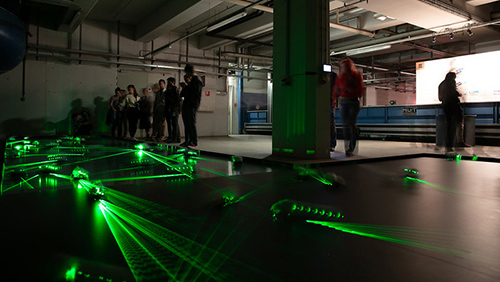 © vog.photo
© vog.photo
Comment from KANNO So
My exhibition location was in the bunker. There were pillars in the way that could interfere with the exhibition, and the sound tended to reverberate. I went into the exhibition with a plan for making an L-shaped stage for the robots to avoid the pillars. I think it ended up working out positively. The sound resonated well and the space was used to good effect. The exhibition was well received by the discerning Ars Electronica audience, and it generated quite a response.
"Japanese Media Art Timeline Infographics Project"
On the rooftop, various materials were exhibited looking back on the past 40 years of Ars Electronica. This project, which was a retrospective on Japanese media art specifically, was displayed in the last corner of the rooftop, impressing viewers with its historical perspective.
Campus Exhibition by Aichi University of the Arts (AUA) : "The Philosophy of Drawing" exhibition
"Constellations of the Earth" (2018, SUZUKI Hiroshi and OHKI Masato), "Portraits" (2018, OSAKI Nobuyuki), and "Bodiject-oriented" (2018, KODAKA Kenri) were displayed as part of Japan Media Arts Festival overseas promotions, and other works by DTG (OIZUMI Kazufumi + KATO Yoshimasa), YAMAMOTO Tsutomu, ISHIKAWA Hina, KATAOKA Isato + SEKIGUCHI Atsuhito were displayed.
This year, 57 universities from around the world participated in the campus exhibition, exchanging various ideas and approaches in addition to their displays. These exhibitions were some of the more interesting amongst them, attracting many visitors and lively discussions.
Comment from SUZUKI Hiroshi("[Takahagi_za] Constellations of the Earth")
This work was displayed at POSTCITY as part of the "Philosophy of Drawing" Campus Exhibition and was planned by Professor SEKIGUCHI Atsuhito (Aichi University of the Arts). This gave us a place where we could introduce our work not only to the citizens of Linz, but also to artists, scientists, etc., from many different countries. Additionally, it was an opportunity to hear opinions about the works from visitors who have a wide range of expertise. With this exibition, we were able to display graphic works (acrylic mounts) that were outputted as digital chromogenic prints, expanding the range of images conveyed to visitors.
Comment from OSAKI Nobuyuki("Portraits")
My work was a video installation, and though it wasn't made using cutting-edge technology, I received a lot of responses from visitors. This was a very good experience for me, as I was able to experience the meaning and significance of Ars Electronica as a great platform for predicting future thinking and society through media art. I've mainly been presenting in contemporary art museums and galleries, so these experiences have been fresh and exciting for me. I also thought it was a great opportunity to be able to interact with many different people, be asked a range of questions about my display piece, discuss new ideas, and more.
Comment from KODAKA Kenri("Bodiject-oriented")
I participated in the "Philosophy of Drawing" exhibition, which was a collection of a wide variety of works. Of all the works in the Campus Exhibition, I think this attracted quite a lot of visitors. As a result, we were fortunate and received interesting reactions from people of all ages and cultures. Elementary school children in particular had a tendency to step away from their parents and glue themselves in front of the "Bodiject-oriented" video. To me, this is compelling evidence that the psychological effects of this work have a universal cognitive foundation.
"Play Back" Curing tapes (2018)SHOJIKI(KOBAYASHI Muku, TOKISATO Mitsuru)
This performance took place at St. Florian Monastery on September 7 (Saturday) from 15:30 to 16:00.
The performance was held in a beautiful, majestic church, with a gallery of people of all ages, from children to adults, packed in and enraptured with the display. The unique music, requiring physical manipulation of magnetic and curing tapes, begins quietly, but the excitement gradually builds. The audience found themselves lost in this esoteric yet strikingly beautiful music.
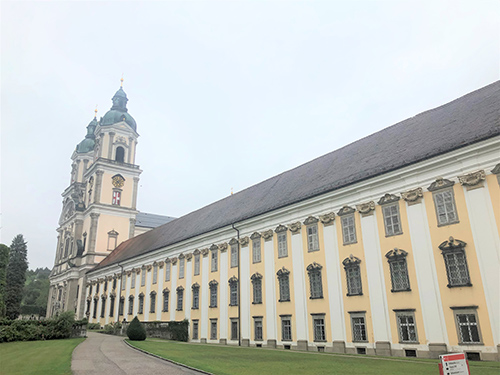

-
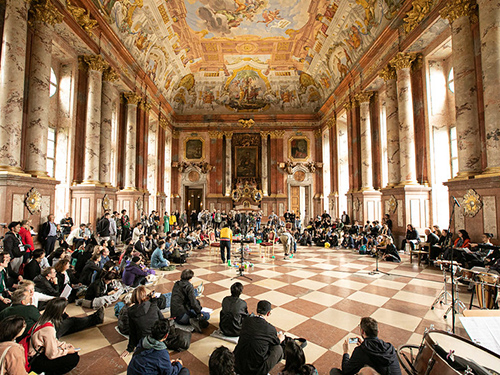 © vog.photo
© vog.photo
-
SHOJIKI “Play Back” Curing Tapes @St. Florian Monastery from TOKISATO mitsuru on Vimeo.
Comment from KOBAYASHI Muku
My first visit to Ars Electronica was this milestone 40th anniversary. Although it's a leading festival in the field of media art, that isn't a formal genre, and so I was able to glimpse upon a number of strange and uncategorized things. They can't simply be called "new", but I think a perspective oriented toward the unknown has been nurtured over these past 40 years. As such, even our performance garnered a response from a wide range of people. I'm glad I was able to be a part of Ars Electronica during this important year.
Comment from TOKISATO Mitsuru
We performed in the Ars Electronica AI x Music Festival program as SHOJIKI. The venue where we performed was a marble hall in a church called St. Florian Monastery.
Our performance was the opposite of AI, but it was extremely exciting nonetheless. Especially considering how interesting the venue was, including how the acoustics sounded and how luxurious the decorations were. I'd like to make use of this experience in the future.
Ars Electronica History Summit : "40 years of Japanese Media Art"
This symposium on both the past and the future of Japanese media art was held on September 5 (Thursday) from 16:00 to 17:00 in the POSTCITY Conference Hall.
Panelists included SHIKATA Yukiko, SEKIGUCHI Atsuhito, HATANAKA Minoru, KUSAHARA Machiko, and KAWAGUCHI Yoichiro, with Christa SOMMERER as the moderator. They discussed the development of Japanese media art from various perspectives.
Comment from SHIKATA Yukiko
The "Japanese Media Art" session in Ars Electronica's 40th anniversary "History Summit" demonstrates the long-standing success and contribution of Japanese media art to Ars Electronica. It was a valuable opportunity for myself and others to learn about the historical circumstances and characteristics of Japanese media art. Christa SOMMERER, who was teaching at IAMAS, acted as moderator, while myself and the other speakers, KAWAGUCHI Yoichiro, KUSAHARA Machiko, SEKIGUCHI Atsuhito, and HATANAKA Minoru, spoke from our different perspectives. I am convinced that the understanding and interest regarding Japanese media art has become further widespread thanks to highly regarded artists such as KANNO So, who also participated in this year's Ars Electronica.
Comment from SEKIGUCHI Atsuhito, General Director
As part of the Japan Media Arts Festival overseas promotions for the first year of the Reiwa era, I participated in the international media art festival "Ars electronica Festival 2019", helping to plan and curate it.
Based around the theme of "daily algorithms and expressions generated by the body", KANNO So had the exhibition "Lasermice" (2018), while SHOJIKI (KOBAYASHI Muku and TOKISATO Mitsuru) performed their sound oriented "Play Back" Curing Tapes (2018). Additionally, for the 40th anniversary of Ars Electronica, a symposium on the deep history of Japanese media art was held, showing various items and events from different fields and eras. On the POSTCITY rooftop, the 40-year history of Ars Electronica was shown together with the history of Japanese media art starting from the 1950s, presented as the "Japanese Media Art Timeline Infographics Project" and showing the relationship between the Japan Media Arts Festival and Ars Electronica. The works of SUZUKI Hiroshi, OHKI Masato, KODAKA Kenri, and OSAKI Nobuyuki were displayed at the Campus Exhibition as Japan Media Arts Festival selected. "Lasermice" demonstrates the strength of its expression as its exhibition space increases in size. In an open environment, the exhibition gave off the impression of an even livelier work. "Play Back" Curing Tapes was performed at St. Florian Monastery. This work contrasted the unwinding of cheap tapes with the royal court culture of this vast indoor space, providing a performance that really made the physicality of this artistic expression stand out.
-
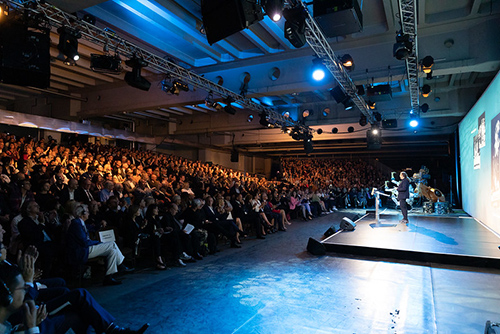 © Jürgen Grünwald
© Jürgen Grünwald
-
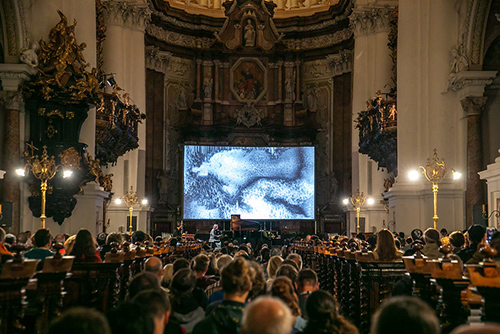 © vog.photo
© vog.photo
-
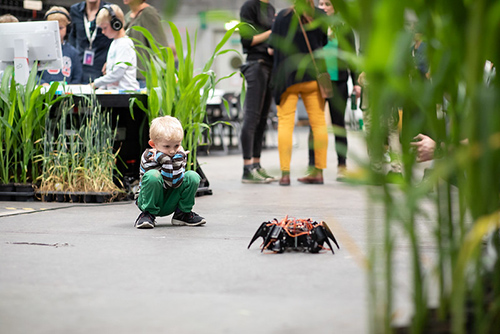 © Philipp Greindl
© Philipp Greindl
-
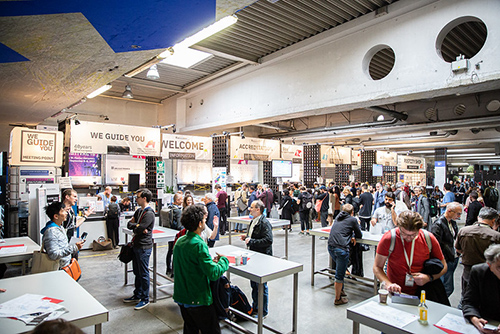 © tom mesic
© tom mesic
-
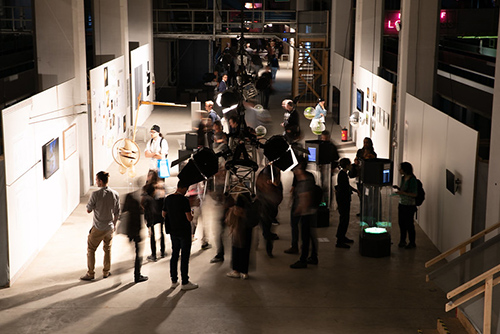 © vog.photo
© vog.photo
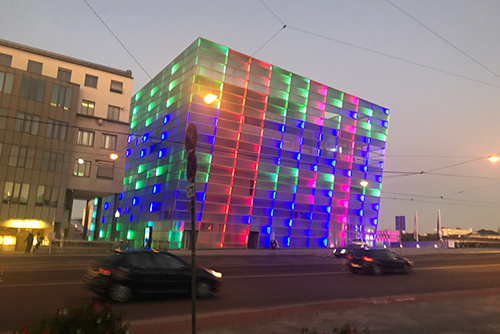
This was the last year Ars Electronica will be held at POSTCITY.
Next year it will be held from September 10 to 14 at Johannes Kepler University in Linz.
The hope is that this project continues to place a focus on the festival, which is a keen and biting approach to art, technology, and society.
Report on the School of the Future Festival
The Japan Media Arts Festival overseas promotion participated in the School of the Future Festival, which was held at Tokyo Midtown from February 20th to 24th 2020. The following is the report on “Japanese Media Art Timeline Infographics Project” exhibition and talk session, which also served as a project review for the Ars Electronica Festival 2019.
What is SCHOOL OF THE FUTURE FESTIVAL?
The “SCHOOL OF THE FUTURE FESTIVAL” by Tokyo Midtown and Ars Electronica is a new event for thinking of our future society together with a broad variety of visitors. Artists, companies and university at Tokyo Midtown will show visitors their finely honed works, projects and products. The concept of School of the Future is “a new place to think about the future, something that is not taught in school, through art and design.” Visitors to this event can freely experience fun programs, such as exhibitions, performances, workshops and talks, for kids to adults. Surely, important hints might be found for thinking about the future.
Theme of the second SCHOOL OF THE FUTURE FESTIVAL: “Dappi / Out of the Box”
Invisible walls among society. Self-limiting beliefs. We are often unaware of blindly accepting existing standards and values. Still, many people struggle to get out of the box seeking a better future, or personal growth. Whereas it seems hard for humans to do so, some living creatures shed an old skin, casting off one’s old self.
“Dappi (脱皮)” is a Japanese term for shedding. Consisted of two letters , “脱 strip off” and “皮 skin,” it implies breaking through walls for transformation.
This festival invites visitors to experience metamorphosis into a new state, through artworks and projects that get rid of stereotypes, push us out of comfort zones. Learn to harness the power of art to move beyond the status quo.
『1950-2020 Japanese Media Art Timeline Infographics Project』
| Place | : | Tokyo Midtown Metro Avenue |
| Size | : | H 1.6m x W 10.5m |
| Planning and Production | : | Japanese Media Art Timeline Infographic Projects |
At the exhibition, we presented a timeline infographic that gives an overview of Japanese media art-related events beginning from the 1950s to the present. The new infographic was enlarged to roughly double the size of the previous one, which had a 5-meter width when it was exhibited at POSTCITY during the Ars Electronica Festival 2019. The enlarged infographic was visibly displayed right at the passage from the entrance. The contents and the impressive design of the infographic had a substantial impact on the viewers and successfully attracted many visitors to the exhibition.
“Japanese Media and Art”
| Date and time | : | February 24th (Mon), 16:30 - 18:00 |
| Venue | : | Tokyo Midtown Design Hub International Design Liaison Center |
| Speaker | : | SEKIGUCHI Atsuhito (Artist / Professor, Aichi University of the Arts), KUSAHARA Machiko (Professor Emerita, Waseda University / Visiting Professor, Digital Hollywood University), OCHIAI Yoichi (Media Artist) |
| Moderator | : | OGAWA Emiko (Head of Prix Ars Electronica) |
We had a talk session on the theme, “Japanese Media and Art”. Although the event was on the last day of the festival, we not only had a full house, but also enthusiastic standing-room participants. We covered topics such as how Japanese media and art influences Japanese society in the past 50 years, and how media art transformed over time until the present. We also examined the international recognition of Japanese media artists through the eyes of Ars Electronica and exchanged opinion about the history of media art in Japan and the future role in the society.
Comment from SEKIGUCHI Atsuhito
At the second School of the Future Festival, we had the opportunity to install a newly expanded version of the Japanese Media Art Timeline Infographics Project. Initially, the original version of the infographic was exhibited at Ars Electronica festival in September 2019. This time, we presented our new timeline infographic, which displays events that happened during the last 70 years, from the 1950s to the current year of 2020. The chart was depicted within a 10-meter-wide frame. We gave a presentation based on the analyzed contents of the timeline. It was hard to summarize the disconnected activities, but we were able to discover six different eras within the timeline. Because of this discovery, we could provide an easy-to-understand introduction about Japanese media art to the audience. We also asked Mr. OCHIAI, Ms. KUSAHARA, and Ms. OGAWA, to talk freely about their impression of the project. It was a surprise to find out that Mr. OCHIAI places greater importance on the activities as an artist than as a scholar.
Comment from KUSAHARA Machiko
Unfortunately, Christa SOMMERER’s visit to Japan was canceled suddenly. However, after Mr. SEKIGUCHI’s presentation on the history of Japanese media art, Mr. OCHIAI, along with writer and moderator Ms. OGAWA Emiko, gave a great in-depth discussion about media art from the 1980s to the present. We were able to see essential images on the screen instantaneously, and some participants were eagerly taking notes on the topics. As Mr. OCHIAI proposed at the talk, we should continue to investigate the artwork conservation issue from here on out.
Comment from OCHIAI Yoichi
From the conversation between Ms. Ogawa, Prof. Sekiguchi and Prof. Kusahara, I was able to reconfirm the context of Japan's postwar industrial development, national events, and the lineage of interactive art that followed. The 70-year history, which is colored by various keywords; physicality and media devices, materiality, animation, games, minimalism, traditions, and various keywords, is fresh, I reaffirmed Japan's environment for fostering media art. These discussions became the foundation for me to think about preservation of media art and market issues.




